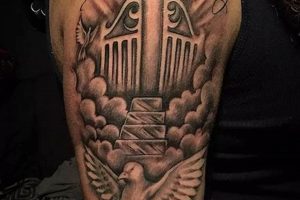Representations of faith and spirituality through body art are increasingly common. Scriptural verses, iconic imagery, and symbolic depictions drawn from biblical narratives offer a powerful means of personal expression. For example, a cross, a dove, or a verse like “I can do all things through Christ who strengthens me” (Philippians 4:13) can serve as potent visual reminders of belief and commitment.
Such permanent displays of faith can provide comfort, inspiration, and a sense of connection to something larger than oneself. They can also serve as conversation starters, opening opportunities to share one’s beliefs and values with others. Throughout history, different cultures have used body art to signify religious affiliation and spiritual journeys. This practice continues today, adapting to modern aesthetics while maintaining a deep connection to ancient traditions.
Exploring specific design choices, artistic styles, and their associated meanings can offer a deeper understanding of this form of expression. Consideration of placement, size, and the artistic expertise of the tattoo artist are also key factors in creating a meaningful and aesthetically pleasing result.
1. Verse Selection
The foundation of scriptural body art lies in the chosen verse. This selection acts as the core message, permanently etched onto the skin. Careful consideration of personal meaning, desired aesthetic, and overall impact is crucial for a truly resonant piece.
- Personal Resonance
The chosen passage should hold deep personal significance, reflecting individual beliefs, values, or experiences. Whether a source of strength, comfort, or inspiration, the verse should resonate deeply with the individual’s spiritual journey. For example, someone seeking strength might choose a verse about courage or resilience.
- Brevity and Aesthetics
Shorter verses often lend themselves better to tattoo design, offering a concise and visually appealing presentation. Longer passages can become cumbersome and difficult to read. Visual appeal should be considered alongside the message. “Love is patient, love is kind” (1 Corinthians 13:4) is a popular example due to its brevity and powerful message.
- Language and Translation
The specific translation of the chosen verse can significantly alter its meaning and aesthetic. Different versions offer varying nuances and stylistic choices. Comparing translations and selecting the one that best captures the desired meaning and tone is essential. The King James Version, for instance, has a distinct poetic quality that some may prefer.
- Contextual Understanding
Understanding the broader context of the chosen verse within its chapter and book is critical. A verse taken out of context can misrepresent its original meaning. Thorough research and reflection on the verse’s full meaning prevent misinterpretations and ensure the intended message is conveyed accurately.
These facets of verse selection contribute significantly to creating a meaningful and impactful scriptural tattoo. The chosen verse sets the tone and serves as the centerpiece, informing the subsequent design choices and ensuring a lasting connection to the individual’s faith and beliefs.
2. Visual Symbolism
Visual symbolism plays a crucial role in enhancing scriptural body art, adding layers of meaning beyond the written word. These symbols, drawn from biblical narratives and Christian iconography, offer a powerful visual language that complements and expands upon the chosen verse. The effective use of symbolism creates a richer, more nuanced piece, resonating with both the individual and those who view it.
Consider the image of a dove. Often representing the Holy Spirit, a dove tattoo can symbolize peace, purity, and divine guidance. Paired with a verse about hope or new beginnings, the dove reinforces and amplifies the message. Similarly, an anchor can represent hope and steadfast faith, drawing from Hebrews 6:19, where hope is described as an anchor for the soul. A crown might symbolize God’s sovereignty or the promise of eternal life, while a cross remains a powerful symbol of sacrifice and redemption. Choosing appropriate symbols that align with the chosen verse’s message creates a cohesive and meaningful design.
The selection of visual symbolism requires careful consideration of its historical and cultural significance. Some symbols hold multiple interpretations, and understanding these nuances is essential for avoiding unintended meanings. Researching the symbolism within biblical context and Christian tradition ensures the chosen imagery accurately reflects the desired message. Combining well-chosen symbols with thoughtfully selected verses creates a powerful and visually compelling piece of body art that expresses faith and personal beliefs with depth and artistry.
3. Placement and Size
Placement and size are critical considerations in scriptural body art, impacting both aesthetics and the conveyance of intended meaning. These choices affect visibility, readability, and how the design interacts with the body’s natural contours. A small, intricate design placed on the wrist might offer personal reflection, while a larger piece across the back could make a bolder statement. Placement should complement the design, ensuring the artwork harmonizes with the body’s form. A sprawling verse might suit the back or ribcage, whereas a single word or small symbol could be elegantly placed on the wrist, ankle, or behind the ear.
Practical considerations also influence placement and size decisions. Visibility preferences play a significant role. Some individuals may prefer easily concealed designs for professional settings, while others opt for prominent placement to openly express their faith. Pain tolerance also factors into placement choices, as certain areas of the body are more sensitive than others. Size considerations should account for the chosen verse’s length and the complexity of accompanying visuals. A detailed depiction of a biblical scene requires more surface area than a simple cross or inscription. Proportionality is key; an overly large design on a small area can appear cluttered, while a small design on a large area might lack impact.
Successful scriptural tattoos result from careful consideration of placement and size in relation to the chosen design and personal preferences. These choices significantly impact the final aesthetic and the effectiveness of the message conveyed. A well-placed and appropriately sized tattoo ensures the artwork complements the body, effectively communicates the intended message, and remains aesthetically pleasing for years to come. Balancing these elements enhances the overall impact and personal meaning of the chosen scriptural body art.
4. Artistic Style
Artistic style significantly influences the overall impact and aesthetic of scriptural body art. The chosen style dictates the visual interpretation of the verse and accompanying symbolism, shaping the final presentation and how the message is perceived. Styles range from minimalist linework to intricate photorealism, each offering a unique approach to conveying spiritual meaning. A minimalist style, featuring clean lines and simple imagery, can evoke a sense of timeless elegance and understated reverence. In contrast, a more detailed, illustrative style can capture the narrative richness of biblical scenes, creating visually captivating and emotionally evocative pieces. Consider a depiction of the Last Supper: a minimalist approach might focus on the symbolic bread and wine, while a realistic style could portray the entire scene with intricate detail.
The chosen artistic style should complement the selected verse and symbolism, creating a cohesive and harmonious design. For instance, a verse about peace and serenity might pair well with a watercolor style, known for its soft, flowing aesthetics. A verse emphasizing strength and resilience could be effectively rendered in a bold, graphic style. Script choices also contribute to the overall artistic style. Traditional calligraphy fonts can evoke a sense of classic reverence, while modern typefaces offer a contemporary interpretation. Color palettes further enhance the design’s mood and message. Earthy tones can create a grounded, natural feel, while vibrant colors can express joy and celebration. A skilled tattoo artist can guide these stylistic choices, ensuring the final design aligns with the individual’s vision and desired message.
Selecting an appropriate artistic style is crucial for effectively communicating the intended message and achieving a visually appealing result. The chosen style should not only reflect personal aesthetics but also enhance the scriptural message, creating a piece of body art that resonates with both the individual and those who view it. Successful integration of artistic style elevates scriptural tattoos beyond mere decoration, transforming them into powerful expressions of faith and personal belief. Understanding the nuances of different styles empowers individuals to make informed decisions, resulting in body art that holds deep personal and spiritual significance.
5. Artist Consultation
Collaboration with a skilled tattoo artist is paramount in realizing meaningful and well-executed scriptural body art. Consultation provides a crucial bridge between personal vision and artistic expertise, ensuring the final design effectively captures the desired message and aesthetic. This collaborative process allows for a nuanced exploration of design elements, addressing technical considerations and ensuring the artwork’s longevity and visual appeal. A thorough consultation involves discussing verse selection, exploring symbolic imagery, and determining appropriate placement, size, and artistic style. An experienced artist can offer valuable insights into design feasibility, suggesting modifications to enhance the overall composition and ensure its successful execution. For example, an artist might advise against overly intricate details in a small-scale design, suggesting alternative visual elements to maintain clarity and impact. Similarly, they can guide font selection, considering readability and aesthetic harmony with the chosen imagery and body placement.
The artist’s technical expertise extends beyond design aesthetics. They possess an understanding of skin types, healing processes, and long-term ink behavior. This knowledge informs decisions regarding needle sizes, ink types, and aftercare procedures, contributing to the tattoo’s longevity and minimizing potential complications. A consultation provides an opportunity to discuss these practical aspects, ensuring the individual understands the process and its implications. Furthermore, a skilled artist can translate abstract concepts into tangible designs. Clients may struggle to articulate their vision fully; a skilled artist can interpret their ideas, offering visual representations and suggesting elements that resonate with the desired message. This interpretive process transforms abstract concepts into concrete designs, bridging the gap between intention and artistic realization. For instance, a client seeking a tattoo representing resilience might describe the concept in broad terms. The artist can then translate this concept into visual imagery, perhaps suggesting an oak tree withstanding a storm, paired with a relevant verse.
Artist consultation is an indispensable step in the creation of successful scriptural body art. It facilitates a collaborative exchange between personal vision and artistic expertise, ensuring the final design is not only aesthetically pleasing but also technically sound and deeply meaningful. This collaborative process safeguards against potential misinterpretations, technical challenges, and long-term aesthetic issues, resulting in a piece of body art that effectively communicates the intended message and remains a source of personal significance for years to come. Neglecting this crucial step can lead to unsatisfactory results, highlighting the importance of investing time and effort in finding a reputable artist and engaging in a thorough consultation process.
Tips for Meaningful Scriptural Tattoos
Achieving a truly meaningful and impactful scriptural tattoo requires careful consideration of various factors. The following tips offer guidance for navigating the design process and ensuring a result that resonates with personal beliefs and artistic vision.
Tip 1: Research Thoroughly. Deepen understanding of chosen verses and symbols. Explore different translations and interpretations to ensure accurate representation and avoid misinterpretations. A seemingly simple symbol like a serpent can hold both positive and negative connotations within biblical texts, highlighting the importance of thorough research.
Tip 2: Prioritize Meaning over Aesthetics. While visual appeal is important, the primary focus should remain on the chosen verse’s meaning and personal significance. A visually stunning tattoo lacking depth loses its impact over time. A simple, well-placed verse can hold more meaning than an elaborate, yet shallow, design.
Tip 3: Choose a Reputable Artist. Seek an artist specializing in the desired style and possessing a strong portfolio of scriptural or similar work. Their expertise ensures proper execution and artistic interpretation of the chosen design. A skilled artist can elevate a simple concept into a powerful piece of art.
Tip 4: Consider Placement Carefully. Reflect on visibility preferences, pain tolerance, and how the design interacts with body contours. Placement impacts both aesthetics and personal meaning. A discreet ankle tattoo offers personal reflection, while a larger piece on the back might express faith more openly.
Tip 5: Plan for Long-Term Care. Tattoos require ongoing care to maintain vibrancy and prevent fading. Discuss aftercare procedures with the chosen artist and commit to following their instructions diligently. Proper care ensures the tattoo remains a beautiful representation of faith for years to come.
Tip 6: Embrace Simplicity. Avoid overcrowding the design with excessive details or multiple verses. A concise, well-executed design often conveys a stronger message. A single, powerful word can resonate more deeply than a lengthy, cluttered passage.
Tip 7: Reflect and Revisit. Take time to reflect on chosen verses and designs before committing. Revisit the design and discuss any concerns with the artist before proceeding. This ensures alignment with personal beliefs and avoids future regrets.
By adhering to these guidelines, individuals can ensure their scriptural tattoos become powerful expressions of faith, thoughtfully designed and executed to remain meaningful for a lifetime. These considerations contribute to a piece of body art that not only resonates with personal beliefs but also stands as a testament to artistic excellence and spiritual depth.
Ultimately, a meaningful scriptural tattoo transcends mere aesthetics; it becomes a permanent testament to one’s faith, a tangible reminder of deeply held beliefs and values.
Frequently Asked Questions about Scriptural Tattoos
Individuals considering scriptural tattoos often have questions regarding design choices, practicality, and spiritual implications. This section addresses common concerns, offering clarity and guidance for those exploring this form of expression.
Question 1: Are scriptural tattoos considered sacrilegious?
Interpretations vary across religious denominations. Some view body art as a violation of scriptural passages, while others see it as a form of personal expression. Researching individual beliefs and consulting religious leaders can provide clarity.
Question 2: What are appropriate verses for a tattoo?
Appropriate verses depend on individual beliefs and desired messages. Short, impactful verses often work best. Understanding the verse’s context within the broader scripture is crucial for accurate representation.
Question 3: How can one ensure a respectful and appropriate design?
Respectful designs stem from thoughtful consideration of the chosen verse’s meaning and appropriate accompanying imagery. Consulting with religious leaders and experienced tattoo artists can offer valuable insights.
Question 4: What factors influence placement decisions?
Placement depends on personal preferences regarding visibility, pain tolerance, and how the design complements body contours. Practical considerations, such as professional dress codes, also play a role.
Question 5: How does one choose a reputable tattoo artist for this type of work?
Seek artists specializing in fine linework or script tattoos with a portfolio demonstrating experience in similar designs. Recommendations from trusted sources and thorough research are essential.
Question 6: What long-term care is required for scriptural tattoos?
Long-term care involves protecting the tattoo from sun exposure and following the artist’s aftercare instructions. Regular moisturizing helps maintain ink vibrancy and skin health.
Careful consideration of these questions contributes to a more informed decision-making process, resulting in a scriptural tattoo that holds deep personal meaning and remains a source of inspiration for years to come. Open communication with religious leaders and experienced tattoo artists further ensures a respectful and well-executed design.
Exploring further resources on symbolism, artistic styles, and aftercare can provide additional guidance for those embarking on this journey of personal expression.
Conclusion
Scriptural body art offers a powerful medium for expressing faith and personal narratives. Careful selection of verses, visual symbolism, placement, size, and artistic style are crucial for creating meaningful and impactful designs. Collaboration with skilled artists ensures technical expertise and personalized interpretations, resulting in aesthetically pleasing and spiritually resonant artwork. Thorough research and thoughtful consideration of practical and spiritual implications contribute to a lasting piece that reflects individual beliefs and artistic vision.
Ultimately, scriptural tattoos represent a deeply personal journey of faith, translating spiritual convictions into tangible expressions. The permanence of these designs underscores the enduring power of belief and the profound connection between body, art, and spirituality. Choosing this form of expression requires thoughtful reflection, ensuring the final result resonates with personal values and serves as a lasting source of inspiration and connection to one’s faith.







